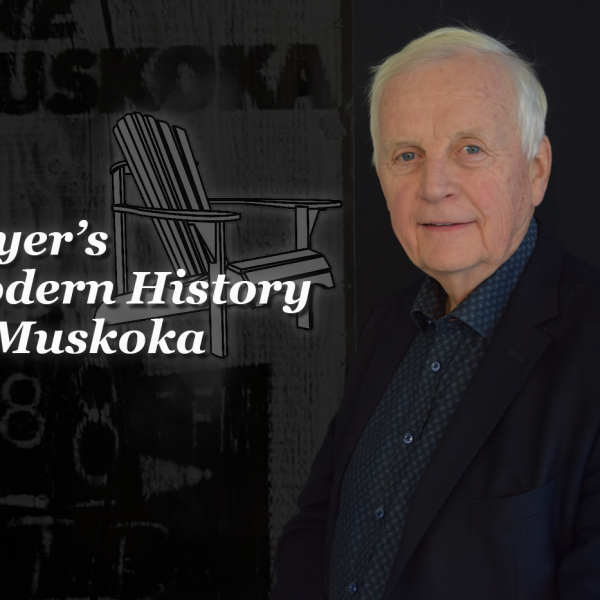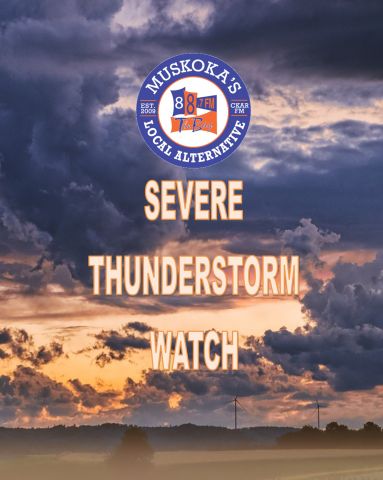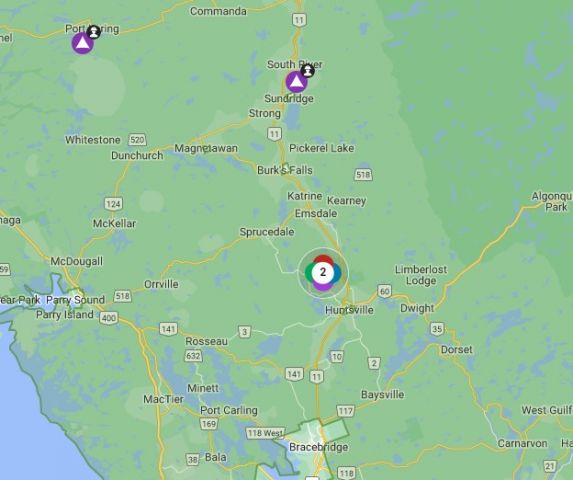Boyer's Modern History Jan 13 2024 - Media in Muskoka
The Broken Mirror
As we start another year of broadcasts about Muskoka’s modern history, each program in 2024 will trace different aspects of Muskoka’s evolving communities and methods of communicating.
Because this subject is as big as it is important for understanding our district and its people, we’ll keep focus by following a single thread that joins all communities and every form of communications – the publication of weekly newspapers.
That means our story will start in1869 when Muskoka’s first newspaper appeared in print, then run for 155 years to the present, when our district entered a twilight zone as all district paper-printed community newspapers vanished on a single day.
Muskoka’s Black Friday: September 15, 2023
On September 15, 2023, the Canadian news publishing conglomerate Torstar Corporation, owner of both the Toronto Star newspaper and the Metroland Media Group that was publishing 70 community newspapers in both printed and on-line editions, filed for bankruptcy protection and ceased production of all weekly community newspapers, moving to an on-line only model. That was the end of the line for the Huntsville Forester, Bracebridge Examiner, and Gravenhurst Banner in their familiar and valuable newspaper editions.
Early that morning, which I call Muskoka’s Black Friday, the week’s supply of thousands of printed flyers ready to be bundled and distributed with the Muskoka newspapers were tossed into a large, overflowing dumpster at 345 Ecclestone Drive in Bracebridge where Metroland did this work. Despite the difficulties for those who produced all that costly material, that symbolic trashing was the least of Muskoka’s problems as we entered an era without local newspapers.
Another symbol of this change is the public meeting the District of Muskoka will convene in its council chambers at Bracebridge next week, to address just the specific problem of alternate communication methods for planning applications. Even for Muskoka’s seven municipal governments, who generally do poorly informing people about their activities and are now much worse off without the newspapers they relied on to help them, there is an unfamiliar void in which to operate. Paperless Muskoka impacts everyone.
Businesses and community organizations are grappling with their conundrum of communicating certain information to the public now that in-print community newspapers no longer circulate throughout Muskoka. The district’s legal profession, too, has formal obligations to give public notice, some specified by statute such as in relation to estates and bankruptcies, other required by rules of procedure governing notification to the legal profession, parties to an action, the general public, and news media. In Muskoka, that reliable method of communication for more than a century and a-half no longer exists.
Death of Muskoka’s In-Print Newspapers
The death of Muskoka’s paper-printed newspapers on Black Friday, when their out-of-district corporate owner announced that only on-line editions of these publications would be available, was not a sudden development. Signs of decline had been present for several years. Still, it caught many by surprise and sent a shock wave through the district.
That was understandable. For more than a century and a-half, the daily lives of Muskokans included newspapers. These weekly publications evolved in dozens of ways, as we’ll see in coming programs. Some published awhile then folded, others amalgamated, new ones appeared. As the communities changed, so did the papers of which they were part.
In the months ahead, we’ll trace the evolution of Muskoka’s community newspapers in order to understand where we are today. We’ll examine how new communications technologies affected publishing and people – from the methods of news gathering and printing, to the ways community retail stores and social organizations operate.
These modernizing changes came, as we shall see, wave after wave: the printing presses, the postal system, telegraph services, telephones, radio, television, satellite communications, the Digital Revolution, and the emergence of online platforms.
(By the way, when television came in, experts said that would be the end of radio. Well, here we are three-quarters of a century later, and I’m on Muskoka’s community station, Hunters Bay Radio, which itself has shifted with the times, from the AM to FM band, for instance, and having me broadcast about Muskoka history instead of my long-dead grandfather George Boyer, whose voice was heard over these airwaves in the 1960s.)
Metroland Broke Muskoka’s Mirror
The quest of individuals and corporations to build empires in movie making, radio and television networks, book and magazine publishing, and newspaper chains is a longstanding challenge to freedom and democracy. When Torstar and its corporate extension Metroland opened their chequebooks and tempted local newspaper owners with a row of zeros, it operated like a vacuum to detach from the communities weekly newspapers that did not have deep enough roots to withstand the suction. The fact these smalltown publications became part of “Metroland” is on a par with the several hundred supermarkets and groceries stores across the country displaying their “Metro” signs as the metropolis spreads ever out, embracing folks beyond metropolitan Canada.
With each advance in communication technology culture shifted, communities altered, and newspapers changed. The pivotal concept is that throughout all the decades this was happening, Muskoka’s newspapers held up a full-sized mirror to the district’s communities in a way that fragmented digital platforms cannot. Black Friday broke Muskoka’s mirror.
To come to terms with this situation, in which we can at best only glimpse fragments of our community, we’ll need to trace forward from the beginning which means starting with pioneer era newspapers in the 19th century.
Beginnings of Muskoka’s Newspaper Heritage
It was in 1869 – two years after Confederation – that the first paper to be published in Ontario’s northern districts appeared. The Northern Advocate’s publisher was Thomas McMurray who was first reeve of four combined Muskoka townships, owned and operated several businesses in Bracebridge, and was Muskoka’s leading advocate for settlement under the free land program for homesteaders. Like his newspaper, Thomas was himself a most ardent northern advocate. Editor of the Northern Advocate newspaper was James Boyer, my great-grandfather.
Their paper initially served Muskoka, Parry Sound, and Nipissing districts. It continued for a number of years, until its place was taken by the Muskoka Herald and its competitor, the Bracebridge Gazette – introducing lively competition for news, readers, advertisements, and community influence. Adding to the competition was that one journal supported the Conservatives, the other, the Liberals – about the way Stephen Leacock portrays for Orillia in his 1912 book Sunshine Sketches of a Little Town.
Gravenhurst’s first newspaper certainly mirrored its community, a busy lumber centre whose many sawmills gave the village its deserved nickname “Sawdust City.” The community’s inaugural paper, named the Canadian Lumberman, began in May, 1876. Owned and operated by Orillia publisher Peter Murray, the Canadian Lumberman was edited by entrepreneurial A.P. Cockburn while also busy with his steamships, other business interests, and serving as Muskoka’s Member of Parliament. Only six months after it began, the Lumberman folded. By 1880, another Orillian, William Russell Tudhope, launched a newspaper he called the Muskoka Banner. The 4-page paper was printed in his Orillia Times newspaper office. By 1886, Bill Tudhope changed his paper’s name to Gravenhurst Banner.
Huntsville, perhaps not surprisingly for a community with many principal inhabitants affiliated with the Liberal Party, got its first newspaper when Francis Howland, who enjoyed being first, started a weekly. He had already been Huntsville’s first doctor, was recipient of the village’s first telegram, owned the first tennis court, and had been appointed the community’s first medical officer of health by Ontario’s Liberal government. In 1876, displaying his political affiliation on its masthead, Howland named the village’s first newspaper the Liberal. With no printing press in town, the Liberal was printed in Bracebridge until Whitby newspaper publisher Floyd Clearwater relocated to Huntsville in 1877. Transporting his printing press with him, he struck up a deal with Howland, and acquired a half-interest in the doctor’s weekly. Later that year, veteran publisher Clearwater knew that to broaden subscriptions and increase advertising beyond Liberal enthusiasts, changing the newspaper’s name was a necessary upgrade – and that’s how Huntsville’s Liberal became the Forester.
The Nature of Community-Based Newspapers
When it comes to the importance these community newspapers as mirrors to their communities – reflecting and shaping the life of Muskokans and events of the district ever since the 1860s – it helps to know how papers did this for Muskoka, and still do in communities that successfully held out against the acquisitions rampage by Toronto Star’s Metroland.
Whether the newspaper is a small town weekly or big city daily, it gives readers a reflection of themselves. Each reader can find what he or she wants to know that is of business, social, or personal interest for their own connections with the community.
The paper’s news, public notices, and advertisements continuously update people about what is happening across their community and its many components. It reveals changes from the rise and fall of sports teams and political careers to the building of new hospitals and schools or the demolition or repurposing of old ones.
A community’s human evolution can be traced through birth notices, graduation ceremonies, wedding reports, and obituaries. Activities of churches and curling clubs are recorded alongside news about the community projects and doings of service clubs like the Rotarians, Kiwanians, Lions, and Kinsmen. Over time, the weekly becomes a journal of record, preserving its community’s history.
All this and more is offered in one convenient place, well written, and appealingly presented according to the current state of graphic arts. A newspaper can be carried anywhere, read at anytime, even clipped for items of importance or special interest. Muskoka households have many scrapbooks of treasured newspaper items.
The paper-printed newspaper does not spy on you and profile you to intrusive advertisers. A printed newspaper in your hands is an entirely private communication of public information.
Newspapers and Communities Develop a Symbiotic Relationship
The newspaper emerged as an institution of distinction, dynamic in operation, dependant on the symbiotic relationship with its community. In this mutual interdependence of two different entities sharing the same space, people working for a newspaper went into the community to find news and sell ads, but people also came to newspaper offices themselves, or mailed things in, knowing the weekly sheet was seen and studied by several thousand people in the case of Muskoka’s weeklies, or a million readers for the metropolitan papers.
In came press releases, announcements, letters-to-the-editor expressing a point of view, and want ads for the community marketplace that would inspire creation of Kijiji and Craigslist. Rural correspondents mailed weekly news of local doings in their smaller communities, holding mirrors to those places whose residents searched each week to see if their name made it into the paper, walking taller when it did.
Of vital importance for human communities is being able to see and understand our collective activity and communal character.
The Compelling Drift to Digital
To conclude this preliminary overview of paperless Muskoka, I’ll jump ahead in the story (to be continued in future programs) to add these points.
The most recent communications advance that affected Muskoka and our community newspapers – like a tsunami washing over everything else, too – was the digital revolution. This landmark event in Muskoka’s modern history delivered a major change to journalism and community newspapers, but the district is hardly unique in this because the digital revolution has caused a global makeover.
What is unique to Muskoka, however, is that the Digital Age’s revamping of communications was accompanied by a second development. Muskoka’s locally owned and operated weekly newspapers, the Gravenhurst Banner, Bracebridge Examiner, and Huntsville Forester, and related newspaper assets, were all sold by their two owners to non-Muskoka media conglomerates. Overnight, Muskoka’s newspapers became foreign owned.
The publishing conglomerate adding our local weeklies to its holdings was not foreign meaning non-Canadian, but foreign in terms of its business model and operations, foreign in terms of its understanding of Muskoka’s distinct culture, foreign in asserting top-down control over local newspapers and providing content and direction from head office.
This flawed business model of a centralized and top-heavy newspaper conglomerate running scattered weekly newspapers created financial problems that led to successive cutbacks until the Muskoka weeklies, tied to a hollowed-out business entity, vanished from one week to the next.
Online, the Forester, Examiner, and Banner continue to be confusingly enwrapped under something called MUSKOKA REGION – a Toronto view that does not recognize Muskoka as a district. For awhile, head office applied this name to its split-run editions of all three papers, a mashup that was as hard to manage from the production side as it was to sort out from a reader’s perspective, causing head-office to revert after a couple years to the three papers’ original mastheads.
Besides those three, Muskoka has other on-line news publications. In 1994, Mark Clairmont founded his digital paper Muskoka Today, produced in Gravenhurst. In 2015, after the Forester had become just a link in a big newspaper chain, Huntsville journalists craving better coverage of local news launched the Doppler, an on-line publication which now also has an extended South Muskoka platform. Muskoka Crime News, Simcoe-Muskoka News, and Muskoka Airport News are three more online news outlets. Hunters Bay Radio reports news and posts breaking stories on the station’s website. Muskoka culture and arts news is found at muskokastyle.com, among other platforms. We’ll examine the advantages and drawbacks of digital journals in a thorough way as this series progresses.
Was a Paperless Muskoka Inevitable?
The business model of locally-owned and operated community newspapers is still successful in parts of Ontario and beyond where paper-printed journals remain in vital operation, including in adjacent Haliburton. Perhaps if the Huntsville Forester’s owner had kept it under local operation and the proprietor of the Bracebridge Examiner and Gravenhurst Banner retained control of these community publications as well, given their extensive respective experience as weekly publishers and editors, I believe the odds are overwhelming that one of these publications would have survived, likely two, and possibly even a third, and that Muskoka and Muskokans would now still be benefitting from our community mirror.
Instead, these distinctive Muskoka papers first lost their identity being run with top-down management and supplied content, and have since slipped, exclusively, into borderless cyberspace. That is why Muskokans occupy an awkward alien space for the first time since settlement in the 1860s: complete absence of paper-printed local newspapers to show us who we are, what’s happened, and what’s ahead – all the while preserving a tangible historical record in the process. Perhaps, for the only county or district in Ontario without a public archives, this is karma.












